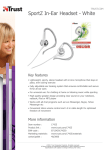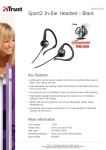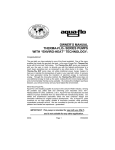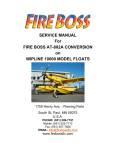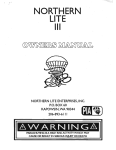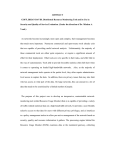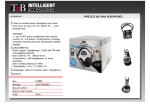Download owners manual pdf
Transcript
BIG AIR SPORTZ, Inc. Main Canopy Owners Manual E-mail: [email protected] Website: www.bigairsportZ.com Phone: (845) 876-3008 Welcome to the family! You are now the proud owner of a brand new BIG AIR Sportz canopy. Here are some things that you need to know about your canopy. Please read ALL OF THIS thoroughly before jumping your new parachute. If you still have questions, please feel free to call us. Information makes us all safer. To assume that one knows everything only brings one closer to demise. Open mind, Healthy life. Table of Contents Canopy Information....................................................................................................... 6 Fabric: ........................................................................................................................ 6 Lines: ......................................................................................................................... 6 The Airlock System: ................................................................................................... 6 Reinforcements: ......................................................................................................... 8 Load Tapes ................................................................................................................ 9 Cross-Ports: ............................................................................................................. 10 Risers ....................................................................................................................... 10 Pack Volume ............................................................................................................ 10 Canopy Data................................................................................................................. 11 Aspect Ratio: ........................................................................................................... 11 Planform Area: ......................................................................................................... 11 Planform Taper: ....................................................................................................... 11 Wing-Span: .............................................................................................................. 11 Line Trim Specifications: .......................................................................................... 12 Recommended Wing Loading ................................................................................. 13 Packing ........................................................................................................................ 14 Riser Symmetry ....................................................................................................... 14 Slider: Flaking and Placement ................................................................................ 14 Slider: Drawstring/Kill-line ....................................................................................... 14 Line Stows: Types of Elastics ................................................................................... 15 Line Stows: Location of Stows ................................................................................. 15 Pilot Chutes: Size..................................................................................................... 15 Pilot Chutes: Kill Lines ............................................................................................. 16 Stowing the Toggles ................................................................................................. 16 Flight Performance...................................................................................................... 17 Glide ........................................................................................................................ 17 Turns: ....................................................................................................................... 17 Oversteer ................................................................................................................. 18 Flare ......................................................................................................................... 18 Stalls and Stall Recovery: ........................................................................................ 19 Dive Characteristic: .................................................................................................. 20 Essential Aerodynamics For the Ram-Air Pilot: ............................................................................................ 21 Laminar Flow ........................................................................................................... 21 Airspeed = Lift .......................................................................................................... 21 Pitch = Angle of Attack = Airspeed Control .............................................................. 21 Angle of Attack = “G Force” Control ......................................................................... 23 Pendular Stability: Pitch Axis .................................................................................... 24 Roll Axis ................................................................................................................... 25 High Speed Approaches: ............................................................................................ 26 You don’t NEED to swoop this jump ........................................................................ 28 Plan your abort......................................................................................................... 28 Dive Techniques: ......................................................................................................... 30 Front Riser Approaches: Straight In ......................................................................... 30 Heavy Riser Pressure: ............................................................................................. 31 Front Riser Approaches: Turning ............................................................................. 31 Rubber Necking ....................................................................................................... 33 Awareness: The Mind of the Swooper .................................................................... 33 Airlocks After Landing ................................................................................................ 34 Policies ......................................................................................................................... 35 Client Referral Program ........................................................................................... 35 Return Policy............................................................................................................ 35 Danger ..................................................................................................................... 35 Insurance ................................................................................................................. 35 Canopy Information Fabric: Performance Textiles silicone-coated zero permeability “OP3” a.k.a. “SoarCoat” Lines: Spectra suspension lines, with the exception of the outboard lines, on which We use the shrinkage-resistant Vectran. We also use heavy Vectran on the Brake lines. Vectran, with its high melting point doesn’t heat-shrink from slider wear, making it the perfect line material for the high-friction areas that tend to shrink the most. This is the most elegant solution I have found to keep your Samurai in trim as long as possible. Our line-sets should be replaced after 500 jumps. The Airlock System: Airlocks are skins of fabric inside each cell that allow air into the wing, but not out. In other words, the airlocks significantly reduce the rate of change of internal air pressure within your airfoil. This means that your Big Air Sportz canopy will not experience significant spanwise compression oscillations in turbulence. Also, when brakes are applied, the containment of internal pressure actually improves lift through the flare by maintaining the shape of the wing. Our patented one-way valve system is the newest and most advanced Airlock technology, designed by the inventor of the Airlock. Similar to the Jedei and Vengeance method, our Airlock system is second to none. To fully appreciate the stiffness of an Airlocked canopy, you must compare it to similar non-Airlocked designs, switching back and forth on two or more jumps. The most exemplary comparison is to simulate turbulence by jerking the toggles up and down, watching the wing’s reactions to this chaotic input. You will quickly find yourself convinced, as we have, that this is the greatest innovation in ram-air wing designs since Zero-P fabric. A canopy is simply air shaped into a wing. No air, no wing 6 Airlocks in Action TYPICAL RAM-AIR Internal pressure solely reliant upon the relative wind External pressure deforms wing shape RAM-AIR WITH AIRLOCKS Normal flight: Internal pressure gathered from relative wind Dynamic flight: During turns, braking and turbulence airlock is closed. Internal pressure is maintained by airlock valve A consequence of the Airlock system is that the wing does not rely on the external air pressure for its airfoil shape. This means that your canopy will not wiggle and distort in turbulence as much as other designs. Any wing with an open nose is LIMP in comparison. 7 Keep in mind that no flight vehicle is “turbulence proof” A zero-gravity flight mode can introduce all kinds of dangerous possibilities such as linetwists, rapid altitude loss, or wing-bending. Airlock canopies resist instantaneous deflation, but can go into a spin if one wing bends downward. The recovery from such distortion is faster on an Airlocked canopy, however, if the pilot aggressively applies the toggles in order to compress the air that remains inside the wing, thereby forcing the wing back into a stable flying shape. Warning: Airlocks are no substitute for sound judgement as to when to stay on the ground. It’s better to be on the ground, Wishing you were in the air, Than to be in the air, Wishing you were on the ground. Reinforcements: All our canopies are constructed with an integrated Spanwize Reinforcement System (SRS). This series of load-bearing tapes links up the line attachments like a web or net inside the canopy. This system makes Big Air Sportz parachutes among the strongest ever built, including reserves. A diagonal reinforcing tape located at the inboard brake-line attachment on the tail is an elegant solution to a common problem. As a preventative measure to a common damage area, we have added the “DIBBL” tape to the bottom skin of cells 3 and 7 to reinforce this area, as well as to limit the amount of potential diagonal elongation of the skin 8 Lotus Planform A B C D Samurai Planform A B C D at this location during turns and braking. Load Tapes Big Air’s reinforcing tapes on the loaded ribs are positioned at precisely 45 degrees to the blocks of the fabric. This provides maximum weave-bias stabilization, to create the most rigid airfoil rib possible. The traditional “converging” load tapes used in other parachutes form little “dimples” on the top-skin in flight. Our A-B tapes cross below the top of the airfoil, therefore removing the “point-loading” of the topskins near the critical part of the airfoil. Dimples are drag, so we eliminated them. 9 Cross-Ports: The cross-ports in the ribs are not the usual oval shape for a very good reason. The traditional shape creates a localization of stress to occur at the top and bottom of the port as air is passed through the opening. This eventually creates tears, which can evolve into a rib “blow-out”. Our cross-ports are two circular ports, arranged one above the other. This minimizes airfoil distortion, while adding a necessary horizontal structural “member” to the aperture. This maximizes the flow area without compromising the strength of the ribs. Risers BIG AIR SportZ canopies are designed for 21 inch risers, the standard for the industry. When used with standard length risers, our canopies will have a few inches of slack brake-line in full flight. This is to allow the pilot to apply significant front riser input without effecting the tail of the canopy. Long risers (longer than 21”) make the stall point more accessible by placing the jumper further from the canopy. Conversely, shorter risers place the jumper closer to the canopy, thereby making the stall-point further down in the toggle-stroke, or even inaccessible. When using very short risers, (19” or shorter), the factory toggle-setting may feel excessively loose, and may require shortening. Note: Everyone has his or her own personal preferences for toggle setting. If you find the factory setting not to your liking, feel free to change them, but only one inch at a time. You’ll be surprised how much one inch feels like. Keep in mind that bad landings are almost always due to poor technique, regardless of toggle setting. Before changing anything about your new canopy, please contact BIG AIR Sportz to see if this is the right choice for you. Pack Volume The pack volume of our canopies is approximately 5% larger than that of a similar size canopy without an airlock system. Choose your container based on the standard for that size canopy, and adjust your closing loop accordingly. Keep in mind that a loop that is too long can allow the pin to slip out inadvertently, and one that is excessively tight can cause a pilot chute in tow malfunction. 10 Canopy Data Aspect Ratio: Samurai Lotus 2.87 2.77 Planform Area: 95, 105, 120, 136, 150, 170, 190 (custom sizing is available) *Performance Designs Method (bottom span, average chord) Planform Taper: The Samurai is a fully elliptical shape, designed for quick turns and nimble flight. The leading edge is tapered less than the tail in order to help control the heading of the parachute during openings. The Lotus is a mostly rectangular planform, with only a slight curvature of the trailing edge. This design feature was chosen in order to lighten the toggle pressure and quicken the turn rate when compared to contemporary square designs. Wing-Span: (Feet) Size 95 105 120 136 150 170 190 Samurai 15.8 16.6 17.8 18.9 19.8 21.2 22.3 Lotus 15.7 16.4 17.6 18.8 19.7 20.9 22.2 11 Line Trim Specifications (mm): Samurai: Size 95 105 120 136 150 170 190 A-B 69 77 81 86 90 96 103 B-C 124 138 147 158 165 175 185 B2-C2 144 160 171 183 192 203 217 C-D 174 184 196 208 219 233 246 Samurai Only: Rib #2 is 50mm longer than those at the center of the wing Rib #3 is 25mm longer than those at the center of the wing The wingtip is “drooped”, matching the center. Lotus: Size 95 105 120 136 150 170 190 A-B 45 47 50 53 56 60 64 B-C 133 140 150 159 168 179 189 C-D 155 162 174 185 194 207 218 Lotus only: All ribs are the same distance from the jumper. In other words, the “A” lines are all the same length, as opposed to the Samurai line specs. 12 Recommended Wing Loading Wingload is exit weight divided by surface area # of Jumps Wingload (lb/sq ft.) 100+ 1.1* 200+ 1.2* 300+ 1.3 400+ 1.4 500+ 1.5 - 1.8 * Lotus only (The Samurai is a high performance parachute, requiring at least 300 jumps. Use of the Samurai by persons with less than 300 jumps is strictly prohibited, and may result in serious injury or death.) A note on wing-loading: These recommendations are guidelines, not solid rules. BIG AIR leaves the ultimate decision and responsibility of canopy sizing to the customer. But here’s our slogan: “When in doubt, GO BIG!!” 13 Packing The best pack-job for the our canopies seems to be the Pro-Pack, although some customers have found success with other methods. Depending upon the type of opening desired, the nose of the canopy may be rolled “4&4”, toward the center, stuffed in a little, or left alone. Keep in mind that asymmetrical pack-jobs tend to open asymmetrically. Further, we have found that the highest frequency of on-heading openings tend to be associated with pack-jobs that leave the nose alone, in the center of the bulk, with no stuffing or rolling whatsoever. * If you prefer a “snivelling” opening, we can fit your canopy with a slider pocket or “lip” for a minimal cost. Riser Symmetry Elliptical parachutes, being designed for quick turn response, have a higher frequency of off-heading openings. Symmetrical packing of the lines help your canopy to inflate evenly, improving your odds of a straight opening. We recommend tying your risers together at the 3-ring to limit the amount of offset possible during packing. Slider: Flaking and Placement We recommend flaking the slider in four equal parts to maximize the surface area during initial inflation. Pulling the entire slider in front of the nose of the canopy opens the channel of air to the bottom surface, typically allowing the parachute to open sooner. Also, please pay careful attention that the slider stays pressed against the slider stops on the stabilizers. Even one inch of distance between the slider and its stops can cause a harder opening on any canopy. By allowing a significant distance between the slider and the slider-stops, the possibility exists for “slider rebound”, in which the slider bounces aggressively back against the stops and then down the lines. This happens at the moment when the canopy’s lines become taught and the canopy is towed back to the freefall speed. Checking your slider’s location should be the last thing you check before closing your deployment bag. Slider: Drawstring/Kill-line Your slider is equipped with a drawstring “kill-line” for stealthier flight. Please always remember to pull this back to the OPEN position prior to packing it. Your parachute will open VERY HARD if you do not do this! Be sure to pull the slider apart to the fully open position. By fully retracting the drawstring, you are much less likely to have the tab on the end of the line snag in a suspension line cascade possibly causing a malfunction. 14 Stowing your slider is not your highest priority after parachute opening. Fly your canopy! Looking around for other canopies and checking the operation of your own canopy are much more important tasks after opening. Keep your priorities straight. Lastly, please never tie the drawn strings together around your neck. If you have to cutaway, you’ll be very, very sorry. Line Stows: Types of Elastics Use line-stow bands that will do their job. That is to say, if the elastic is unable to exhibit 7-10 pounds of drag before it releases, it isn’t slowing the bag’s ascent from your container. Small, sturdy rubber bands on all the stows seems to be the best way to achieve this holding power, while tubular elastics allow the lines to roll off too easily. Further, the size and condition of the closing stows that pass through the grommets in the deployment bag are essential in the prevention of “line-dump”, which is directly related to extremely hard openings. Very heavy elastics that won’t break, however, can and do cause bag lock malfunctions. As this is a terminal velocity malfunction, it is among the most serious and dangerous. BIG AIR Sportz does not recommend the use of such excessively strong elastics. Line Stows: Location of Stows We highly recommend using “Inboard Line Stows” on your bag. In essence, having the lines stowed closer to the center of the bag will help to reduce the chances of “bag spin”, and therefore line twists. Most riggers can do the modification, but we’d be happy to modify your bag right here at Big Air Sportz. The turn-around time is usually just a few days. Pilot Chutes: Size Your pilot chute size and type will significantly effect your parachute’s opening characteristics, as well as the flight. An excessively large pilot-chute will cause hard openings, or even line-dump, which can cause catastrophically abrupt openings. A pilot chute that is too small may not lift the bag off your back at all, or may allow line-twists to occur as the bag is lifted lazily off your back. We recommend pilot chutes between 26 and 30 inches in diameter proportionate to the weight of the canopy. Freefliers beware: ZP pilot-chutes can slip out prematurely! 15 Pilot Chutes: Kill Lines An inflated pilot chute trailing behind your canopy can distort your wing, as it will continuously be pulling back on the center cell. The extra drag also diminishes flight performance, and may be the deciding factor as to whether or not you make it back from a bad spot. Therefore, a collapsible pilot chute is mandatory equipment for any of BIG AIR’s canopies. We do not recommend the use of bungee pilot chutes, however, as they tend to allow the pilot chute to periodically re-inflate under canopy, and may delay inflation during low speed aircraft exits. The kill-line method is excellent, although carelessness in resetting the kill line during packing may also cause pilot chute in tow malfunctions. Further, a spectra kill line will shrink with age, preventing you from cocking your pilot chute fully. Eventually, this will lead to pilot chute in tow malfunctions. Lastly, is a #8 grommet on the deployment bag. This will allow the bag to invert and slide down the bridle to pilot chute, collapsing it. This is the safest method to collapse your pilot chute, requiring no “cocking” during packing, although the wearing on the mesh of the pilot chute may expedite it’s replacement. This method also usually causes the pilot chute to spin up under canopy. Stowing the Toggles Please stow the toggles and the excess brake line in a manner approved by your container’s manufacturer. Leaving the excess line free opens the possibility of entanglement, particularly with your helmet or camera. This is not merely the recommendation of an over-protective manufacturer; it is a precaution based on experience. A brake-line that is entangled with some part of your body will prohibit you from jettisoning your main canopy. “Toggle-Keepers” are also a necessity on all Big Air Sportz parachutes. This is an elastic or fabric loop that holds the tip of the toggle above the guide ring. Toggle-Keepers reduce the chance of a malfunction due to a brake-release during deployment. 16 Flight Performance This is a high performance canopy, so please be careful with it. We recommend a few high openings (7000’ AGL or above) to really get the feel for it. Glide Both the Samurai and the Lotus have excellent glide potential. The Lotus is designed with a flatter trim and therefore higher glide than the Samurai. We have designed our canopies to flatten out even more with a little rear riser input, and minimal pressure required to hold them down. This effect is improved markedly by pulling the slider down all the way, and pushing the risers to the outside while pulling down an inch or two. This method, applied with the brakes unstowed, is wonderful in all conditions, but is most useful when returning from short, or down-wind spots. If the spot is long but on the wind-line, and the uppers are strong, holding the toggles in 99% brakes will keep you in the upper winds longer, helping you return to the target. Turns: Your canopy is a high performance parachute, with the capability to turn very quickly. At altitudes above 2000 feet above ground level, feel free to explore all of the wing’s flight modes, including steep banks. Notice how much altitude is lost in a single revolution, or even a sharp 180 turn. This will provide you with the essential experiential information for flight below 2000. Steep turns or dives, when performed at a low altitude can cause you to crash into the ground with staggering velocity, and kill you. Be smart. An essential consideration when turning your canopy quickly is line tension. In aggressive turns, you can slacken the suspension lines. When this happens, you have opened the door for such dangerous occurrences as unrecoverable line-twists, or even falling into your canopy. With all of your maneuvers, maintain significant line tension at all times. Your life depends on it. This is done by making smooth toggle inputs, and or using simultaneous opposing toggle input to increase the angle of attack, and thereby the linetension. Also, never reverse direction immediately following an aggressive turn. This is sure to spin you into line twists. 17 Your canopy has the ability to perform level-flight turns, in addition to the descending turns discussed above. Applying simultaneous opposite toggle during, or immediately following the turn will increase the wing’s angle of attack with respect to the relative wind, decreasing your descent rate. This type of turn is often necessary when close to the ground. Performing a descending turn close to the ground can kill you, or anyone near you. Oversteer When flying the Samurai, you will find minimal “over-steer” following toggle turns, but it will over-steer somewhat following front riser turns. Likewise, the fairly deep brake setting used on the Samurai allows for easy “weight-shift’ or “harness” turns after opening, that exhibit this over-steer characteristic. The amount the canopy overshoots it’s heading after ceasing input varies depending on the aggressiveness of the maneuver. The Samurai’s tendency to overshoot it’s heading is usually negated by weight-shift in the harness. The Lotus, being a mostly rectangular planform, exhibits little or no over-steer. If however, the pilot leans in the harness toward the inside of the turn, over-steer characteristics are more similar to elliptical designs. Flare The landing flare on our canopies, similar to most intermediate and high performance wings, is most effective when using the “bump the sweet-spot” method. In other words, make the initial toggle input a bit on the abrupt side. This braking command will “pitch” the canopy into level flight by swinging the pilot forward of the parachute’s center, increasing the angle of attack. The quick deceleration of the parachute allows the pilot’s momentum to swing him or her out in front of the canopy, which is the cause of the increased lift. This method maximizes the speed in the surf, as well as the duration. Flaring too slowly will not significantly effect the angle of attack of the canopy, and therefore is an ineffective method of changing the flight path. By doing this, the only thing accomplished is to loose the precious airspeed necessary for an effective level off when the arriving at ground level. Aim to “surf” within touching distance from the ground. This will prevent a hard touchdown coming as a result of running out of airspeed at a significant altitude. Any distance between the skydiver’s feet and the ground is the distance that he or she will fall when the stall is reached. 18 The perfect landing places the skydiver’s feet on the ground prior to the end of the landing surf, sliding, with knees slightly bent. This allows the pilot to arrest excess forward movement by climbing a foot or so at the final phase of the canopy’s flight. Be aware of the wind velocity and direction when landing. No-wind conditions require the pilot to “finish” the flare. By this we mean flying the canopy all the way to the stall point, just above the ground, in order to minimize the ground speed at touchdown. When landing in windier conditions, the parachute’s ground speed will reach zero when the airspeed becomes equivalent to the wind speed. In other words, when landing facing a 10 mph headwind, the parachute’s airspeed needs to be slowed to 10 mph in order to create a zero ground-speed landing. You will note that your canopy can sustain flight at 10 mph for a longer period of time than it can dwell at the stall point. This will create a longer floating phenomenon at the end of the surf when landing on days with some wind. During the surf, be sure to consciously control the roll axis, preventing the wing from drifting to one side or the other. Having any roll angle at the end of the surf increases the stall speed, and makes your touchdown harder. Keep in mind that we designed the your canopy to curve comfortably in the surf, but only when it still has airspeed. Applying the explanation described at the end of the previous paragraph, this maneuver is easier in conditions with some wind. This is because the parachute still has airspeed, even when hovering with no apparent airspeed. Having the ability to change your heading during the surf is vital for your safety, as obstacles appear at the last second. Practice making slight heading changes in the first part of your surf, when you still have lots of speed, and return the wing to the full upright position prior to touchdown. I recommend trying this maneuver up high for a while, though. When changing your heading during the surf, be careful not to over-bank the canopy at low speed. The higher the bank-angle, the higher the stall-speed. This comes as a result of the increased loading of the canopy when at the higher angle of attack necessary to keep the canopy from descending during the turn. The higher the loading the higher the stall speed will be. What this means is that low-speed high bankangle turns can lead to nasty stalls close to the ground. Airspeed is the cure for such stalls, but only as a preventative measure. This is why such maneuvers must be performed during the primary phase of the landing, when airspeed is still abundant. Stalls and Stall Recovery: Every wing, rigid and fabric alike, has a discrete angle of attack at which it ceases to fly. This is called a stall. When experienced by a ram-air pilot, a stall follows deep brake input or rear riser input, and is followed by a moderate or severe dropping sensation, and backward tilt in attitude. This maneuver, depending on the altitude, method of recovery and duration of event, may be a reasonable safe exploration of the canopy’s slow-flight, or a dangerous stunt that risks the pilot’s life. 19 The aggression of a hasty recovery could, in fact, cause the pilot to fall into the canopy. A stall, when relieved slowly, is a perfectly reasonable activity, which allows the pilot to discover the amount of “toggle authority”, afforded by the current toggle setting. When initiating a stall, do so at an altitude which would allow for a safe cutaway in the event that the recovery goes awry. Once the stall is achieved, immediately but slowly allow the toggles (or rear risers) up to the point of recovery and hold them at the recovery point until the canopy begins to fly again. Only then is it safe to allow the canopy back to full flight. If the stall is relieved aggressively, the resultant forward surge of the canopy will be immediate and violent. A good metaphor is the operation of the clutch on a standard automobile transmission. The clutch is let out slowly to the “friction point” and held there until the vehicle starts moving, and then fully relieved. The same is true of parachute stall recovery. Dive Characteristic: Both the Samurai and Lotus are designed with a somewhat negative “Recovery Arc” when loaded at 1.3lbs/sf or higher. In other words, following a diving maneuver, the canopy will continue to loose altitude until the pilot provides some toggle depression to level out. This is a conscious design choice on our part, so that you will find it easier to hit the “surf-window”. In other words, if you are slowly descending to flare altitude with sustained airspeed, you merely have to wait for the right moment to apply the toggles in order to level off. A wing that levels itself out after an airspeed-increasing maneuver will do so regardless of the altitude AGL. If you are at 30 feet when it chooses to level out, that’s where you stay until the airspeed runs out, and then you get an ankle-burner for a landing. Big Air Sportz canopies will afford you the opportunity to make final approach adjustments on all axes: up, down, and turns. You will learn to love this characteristic when learning how to “swoop”. 20 Essential Aerodynamics For the Ram-Air Pilot: Laminar Flow This refers to the flow of the relative wind as it follows the curved top-surface of a wing. It is this “bending” of the air that provides the lift that allows a wing to glide, rather than fall. This occurs due to the acceleration of the air molecules following the curvature of the topskin, and thereby dropping in pressure. This creates a sort of suction that pulls upward, perpendicular to the center cell. Airspeed = Lift The faster the wing flies through the air, the more lift you have at your disposal, provided that you have the altitude to use the speed to your benefit. No speed, no lift. Pitch = Angle of Attack = Airspeed Control (Fig. 1) Pitch is the relationship of the pilot to the wing fore and aft. Pitch can vary, depending on the flight mode. The range can span from pilot hanging directly below the parachute, in front, or behind the center of gravity. Fig. 1 Slo we r ter Fas 21 Angle Of Attack (Fig. 2) Angle of Attack is the relationship of the wing’s “chord” (a line drawn front to back inside the airfoil), to the vector created by the relative wind, or apparent wind created by the parachute’s flight path. Fig. 2 Angle of attack Line d r o Ch Angle of Attack ß Re lative Wind Direc tion o f mot ion Fig. 3A Angle of attack variations (Angle of attack is not the same as “Attitude” to the horizon) Direction Angle of Attack of motion Nose high attitude with low angle of attack Fig. 3B n io ct re Di Nose low attitude with high angle of attack n io ot m of 22 Angle of Attack Simply put, airspeed is increased when the wing is pointed nose down i.e pitched forward, which also increases the decent rate. This can be done through the use of front riser input, single toggle input, or the relief of toggle input. When the wing flies with a low angle of attack, it has less drag, so the airspeed increases. Conversely, airspeed is diminished when the nose of the canopy is lifted. This is accomplished by applying the brakes or rear risers, which slows the parachute’s airspeed by increasing the canopy’s drag, thereby swinging the pilot forward of center. The net result of such input is a higher angle of attack of the wing, which decreases the decent rate as well as “net “ airspeed. Angle of Attack = “G Force” Control (Fig. 4) “G” force is the effective weight of the pilot, measured in “G’s”. One “G” is equivalent to the pilot’s weight on the ground. Therefore, a 150 lb. pilot will effectively weigh 300 lbs. during a 2 “G” maneuver. Pitch, and thus angle of attack, are responsible for the varying “G” load exerted on the pilot. This change in “G” forces also effects the tension of the suspension lines, as the action of the parachute is not intimately connected the suspended weight. As the pilot applies input to decrease the angle of attack, or dive the canopy, “G” load, or net wing loading decreases. Correspondingly, the line tension is reduced. Thusly, the parachute becomes less stable and less rigid, and thereby more apt to distortion or linetwists. Further, rapid decent close to the ground is not quickly arrested when the lines are slack, and the “G” load is low. When the pilot increases the angle of attack by applying brakes or rear risers, the “G” load on the pilot is increased. Accordingly, the line tension increases in direct proportion to the “G’s” felt by the pilot in the saddle. In other words, the more the pilot performs high “G” maneuvers, the more stable the canopy will be in flight. A nose high attitude isn’t always a high “G” flight mode. If the “G”s need to be increased further, bring the nose up more with toggle input. 23 Fig. 4 One “G” Low “G”s High “G”s Pendular Stability: Pitch Axis Much like a pendulum, the pilot hanging under a parachute has a natural tendency to return to the “neutral” position, directly below the canopy. This principle assumes these important factors: 1) The pilot is providing no additional input of any kind 2) The wing is flying in a stable shape 3) There is adequate altitude for the effect to occur. Parachutes vary with respect to Pendular Stability, based on design, type of maneuver and wing loading. As previously stated, we at Big Air Sportz believe that a parachute that has a slight negative tendency to recover from a dive will be easier to land. With this in mind, it is important to perform final turns fairly high above the ground in order to level off with minimal toggle input. This is because it is optimal to allow the canopy’s natural pendular stability to return you to the neutral pitch position prior to reaching final level-off altitude. If you have to pull your toggles down past your shoulders to recover from your last turn, you have executed your last turn or dive TOO LOW. (See Fig. 6) 24 Roll Axis (Fig. 5) “Roll” or “bank” is another axis of flight that must be monitored especially during landing. When the canopy is banked to one side or the other, the lift vector, which is always perpendicular to the center cell, is changed such that it lies at an angle to gravity. This reduces the effectiveness of your canopy’s lift against gravity, which in turn increases your decent rate. Touching down with any bank angle will serve to reduce your canopy’s net lift, making your landing harder. Roll, however, is what creates heading changes in flight. By producing lift in a more horizontal direction, the wing experiences a force that changes its direction of flight. This is important information when considering turns at low altitude. This understanding allows the pilot to realize that bank is integral and essential for heading change or “yaw”. Without bank there is no yaw. With this in mind, turns requiring little or no altitude loss must begin with bank, but a higher angle of attack is necessary to limit the decent rate. Start the turn with a single toggle input and then pull the opposite toggle as well to increase the angle of attack. This places the pilot further forward of the wing and increases the “G” forces during the turn. It is essential when performing such a level-flight turn, to initiate the maneuver with significant amounts of airspeed. This is due to the increased “G” load on the canopy that comes as a result of the higher angle of attack. As the load increases, so does the stall speed of the wing. This means that it is crucial to recover the wing to the overhead position on the roll axis before the airspeed drops below the critical stall speed. Fig. 5 Lift Lift Lif t Gravity 25 High Speed Approaches: It is true that the faster a wing flies, the more lift it can produce. This assumes, however, that there is sufficient altitude and angle of attack to convert the speed into lift prior to smashing into the ground. If we sound too direct in this point, it is out of necessity. Airspeed increasing maneuvers close to the ground have become a blight on our sport. Hundreds of incidents, both fatal and non-fatal occur each year. It is our belief, at Big Air Sportz, that it is not the maneuver that is the problem, it is the pilot. Education is the answer Fig. 6 Too Low: Whoa! Bad Thing! Smack! 26 A properly executed airspeed-increasing maneuver affords a reasonable amount of safety for the pilot (see fig. 7). This is, however, the result of years of practice coupled with a deep understanding of the parachute. Inexperienced pilots attempting to swoop across the ground at high speed is a formula for disaster for everyone involved, including bystanders. (see fig. 6) Very few experienced swoopers Have avoided incident and injury. That’s why they’re called: “Experienced”. Fig. 7 Ohm... Perfect: Weee! The Corner Wow, what a surf! 27 It isn’t necessary to accelerate the canopy above its natural full flight airspeed in order to achieve a safe and soft landing. Doing so clearly increases the risks, plain and simple. Errors in judgement, or variances in the flying environment can lead to impact forces beyond your imagination’s ability to foresee. Your ego will cloud your ability to picture the consequences, so don’t foster its function. Ego represents a blindfold that shields us from reality. Facing reality is the only way to be safe in this sport. Knowledge, discipline and humility are the only salvation from the carnage that plagues our sport. With this reminder of the potential hazards in mind, let’s look at some thoughts that may help you survive high-speed approaches. You don’t NEED to swoop this jump One must approach the earth with an attitude of “maybe”. Sure, it would be nice to get a great swoop. If the conditions are not perfect, however, you must refrain. This kind of discipline is not easy, or common. Our lives ride on an archetypal decision between willingness and willfulness. Loosen your grip on your swoop. Plan your abort. One must have options before going out on a limb in life. Make sure that any maneuver you perform below 1000 feet is one which can be quickly negated. Aggressively slinging yourself way out to the side in order to pick up speed leaves a period of time during which you cannot save yourself. Practice carving maneuvers so that you can level out immediately in the event that you find yourself too steep too low. In the case of turning approaches, consider the direction and location of your turn carefully. Every degree of your turn should have a safe avenue for an aborted approach. Avoid boxing yourself in such a manner that only a successful execution of the plan will allow you to survive. Rehearse your abort. Execute the diving approach at high altitude over and over, including immediate arrest of your dive. A quick, strong application of the brakes will put you in level flight very quickly, but the action pattern must be natural. The physical behavior must be second-nature, but mental visualization is also essential. Picture yourself reacting quickly to a self induced emergency, stabbing your way to survival. 28 Learn to recognize the signs of a dive gone awry early, before it’s too late. During the dive we rely exclusively on our sight to guide our actions. A good pilot notices that he or she is in trouble early enough to bail out and land safely. A great pilot recognizes the same problem even earlier, and makes adjustments such that the landing looks totally normal and in fact graceful. If The Approach Feels Scary, It Probably Is! The shape of an ill-planned and executed approach is angular; forced in energy. It is the embodiment of “willfulness” rather than “willingness”. Instead of going with the flow, we muscle the turn, the dive, and the recovery. Consequently, the experience is uncertain of outcome and thereby provocative of fear. Further, it looks scary, even to uneducated observers. The perfect high-speed approach is a thing of beauty. It flows like water, fluid in both shape and energy. There are no sharp corners, no abrupt changes in momentum. As a result of flowing with the “Tao” (Chinese concept of Flow), the experience of the perfect approach is one of comfortable, relaxed grace. There is nothing scary about it at all. When you do it right, you will know. (see Fig. 7) 29 Dive Techniques: Front Riser Approaches: Straight In Pulling on your front risers, in unison or asymmetrically, will change the center of gravity of your canopy toward the nose, increasing your airspeed and decent rate. This is a stable maneuver on many parachutes, affording the pilot a good chance of recovery in the event of an excessively low dive. This is due to the fact that the canopy is producing lift throughout the dive, and will generally begin to recover immediately after the front risers are released. Caution: Not every canopy will respond in this manner to front riser input. Many parachutes will buck wildly when the front risers are pulled down. This may be due to brake lines that are too short (flutter in the C-D section), or much worse, instability in the design of the parachute. If the front riser pressure drops significantly as the airspeed increases, or in turbulence, your parachute might not be stable in this flight mode. Keep in mind that front risering in turbulence is a risky endeavor with any parachute, including Airlocked canopies. If you feel a sudden loss of front riser pressure, or an abrupt dropping sensation, release the riser(s) immediately and apply the brakes. Straight front riser approaches will be an easier method for learning to swoop than turning approaches. This approach limits the number of variables we need to keep track of, simplifying the experience. Basically, it’s a waiting game. Face into the wind, toward a clear area, and pull down on the front risers. A few inches is generally enough to increase the speed, so avoid excessive application. Too much input will pull your tail down, as your toggles are still in your hands. Keep your eyes open and wait for the right moment to release them and level off. Don’t forget to breathe. Never let go of your toggles in order to pull on your front risers. Creating speed without the means to recover quickly is quite simply a very bad idea. It is absolutely essential that you experiment with this maneuver at altitudes at least 2000 feet above the ground. Your canopy’s response to such input will vary depending on many variables including: wingloading, length of brake lines, pilot chute size and type, riser length, weather conditions, design of the canopy, and condition of the canopy and line-trim. If your experiments display any instability at all, don’t even consider this as a viable alternative near the ground. It is crucial that you apply front riser input smoothly. Pulling the front risers aggressively can present the top-surface of your wing to the relative wind, making it more susceptible to structural deformation due to turbulence. In such situations, the canopy may experience line-slack, and loose precious altitude quickly. Recovery from such situations requires immediate brake application to the half-brake position. 30 The location at which you grab the front risers is also important. Holding on to long “dive loops” that are located low on the risers will force you to pull your tail, as previously discussed. Pulling the tail is contradictory input, as you are attempting to increase your speed, not loose it. It’s a bit like naming your dog “Sit”. Imagine trying to call him…”C’mere, Sit”… you’d drive him crazy! This is why many swoopers leave their brakes a bit long, so that their tail is straight and aerodynamic during the dive. Also, consider holding your front risers as high as your hands can reach, which will accomplish the same goal. As you recover from the dive, make the transition as smoothly as possible. The change from dive to level flight must be gentle and gradual. If you hear a “popping” sound you simply dropped the front risers, probably because you were too low and got scared. Release the dive high enough that you can enter the surf with minimum toggle input. A good swoop is like skipping rocks on water. Enter the swoop at a shallow angle, rather than straight at the ground. It’s that or make a big splash... Heavy Riser Pressure: On many canopies, the front riser pressure is too high to allow many pilots to pull them down. Initial front riser pressure can be relieved, however. Hold 1/4 brakes before initiation and then release them just prior to riser application. The load factor is then reduced, therby reducing the pressure on the risers. This must be done in one fluid motion and moderately at that. An aggressive flare, release and front riser sequence is a dangerous and unstable manuever that may promote a full frontal collapse. However, a gentle “over-the-hill” kind of manuever can be a pilot’s best friend on a canopy with heavy front riser pressure. “It’s Ballet not Boxing” Front Riser Approaches: Turning The most common method for accelerating the canopy’s airspeed prior to landing is the front riser turn. There are advantages of this method over toggle turning approaches. As mentioned earlier, aggressive toggle turns can promote line slack, which can lead to impacting the ground at high speed. Also, toggle turning approaches do not afford the pilot the option of continuing the dive straight ahead in the event that the maneuver was performed too high. Front riser turns, while more physically demanding, have none of these potential problems, and allow the pilot to adjust every aspect of the approach throughout the dive. 31 Aim to execute your dive too high, And most of the time you will be right on. Once in a while you will plane-out too high, But you will walk away. A high speed approach has many ways in which it may unfold. No two “hook turns” are alike. Sometimes you will find yourself high, sometimes a little low. The key is, adjust before it’s too late. Too High: Sometimes you complete your front riser turn too high, realizing that you are about to plane-out well above surf altitude. This is the safest of the errors that you can make, and is exactly what you should aim for when learning. It is rare that a pilot who turns too high gets hurt. If you realize this is the case, you have two options. 1) Before reaching your final approach heading, pull the other front riser down to match and go straight until low enough to finish the turn to final. 2) If you have rotated all the way to final approach before realizing the error in judgement, you can pull the other front riser to match the one that is driving the turn. You are then performing a straight front riser approach, as described earlier. On aggressive front riser turns: Once you get more comfortable with front riser turns for landing, it can become terribly tempting to throw the turn around with all your might. By doing this, the Load Factor is markedly increased. This means that the weight carried by the parachute is heavier than your body weight, making the front riser pressure heavier. This can result in leveling off too high, as the pressure on the risers may be too much for you to bear. Too Low: The key to surviving a low approach is early recognition of your situation. As mentioned earlier, just because you have started your approach a bit on the low side doesn’t mean that you can’t salvage a great landing. If you realize this is the case, here are your considerations: 1) If you are really low and really steep, hitting your breaks RIGHT AWAY is your only option for survival. Those who hesitate will inherit the earth. 32 2) 3) If you haven’t reached your final approach heading, who cares? Your descent rate is the important issue at this point. Level out, regardless of your heading or roll angle. Pitch is the most important aspect of your life right now. You can deal will secondary issues like roll, yaw, and obstacle avoidance once the ground stops coming at you. If you realize that you are a little steep, a little low, you may choose to let off the riser altogether and finish your turn to final with “weight shift”. This moderate “bail-out” maneuver allows you to continue to dive, but slower than a front riser turn. Toggle may be used to finish the turn as well, but can cause the canopy to level out too soon. It all depends on the specifics of your situation. Rubber Necking When flying your canopy, you must be acutely aware of the other canopies in the air with you. This is especially true when executing aggressive approach methods. By diving your canopy in the pattern, you can rudely enter someone else’s airspace, or even collide with them. “Drive Preventatively”. Remember: “Low canopy has the right of way” Keep your eyes mobile. Look above, below and all around. You may need to abort your hook altogether. The best hook is the one that you didn’t do when conditions were questionable. Awareness: The Mind of the Swooper When your adrenaline begins to subside through repeated exposure, your awareness will begin to increase. This will allow you to make all kinds of adjustments during your dive. We call this process “waking up”. Most skydivers think that they are awake. This is only natural, as our minds manufacture a reality that makes us comfortable enough to jump. The truth is, very few pilots are calm enough to be truly aware of the situation all of the time. Waking up is a continual process in which the enlightened skydiver returns to the present moment. The present moment is reality, and reality is where all of life’s decisions are made. Ego, and all of its presupposed assumptions about what is, takes us from what truly is. Our lives are a journey toward wakefulness, toward bare attention of the present moment, whatever it holds. Awareness can be noticing that someone’s chest strap is not hooked up, even though they are ten feet away from you. Awareness might be seeing another canopy below you before starting your front riser turn for final approach, and aborting the swoop altogether. Wakefulness is all these things and more, and it truly is the key to our survival. Awareness is the answer. 33 Airlocks After Landing As previously mentioned, Big Air Sportz canopies are equipped with the Airlock System. This restricts the exhale of the canopy’s internal air pressure in flight, but also after landing as well. This is a bit of a bother to those pilots unprepared for an inflated wing after landing, but a non-issue for those that have developed a technique for deflating the canopy. We at Big Air Sportz believe that the security of an airlock canopy in flight far out-weighs the small hassle after landing. A fighter jet doesn’t necessarily taxi all that well, but you don’t hear the pilots complaining. This is a flight vehicle first and foremost. With this in mind, here are some “do’s” and “don’ts” for the process of getting back to the packing area with minimal embarrassment. Don’t: Don’t: Hold your brakes down after landing. This will turn your ram air wing into a drag chute. You will most likely go for a ride if the wind is up. Don’t: Pull one toggle in hand-over-hand. This will cause your inflated airfoil to spin around and around, and will not diminish the canopy’s drag or help it to deflate. Don’t: Touch down, turn to face the canopy and immediately start running toward it in an attempt to get around the other side of the canopy. You won’t make it, and you’ll probably end up running a very long way with a fully inflated canopy. Good exercise, though. Do: Do: After touching down, pull down one toggle and pirouette 180 degrees in that direction. Simultaneously lean upwind, away from the canopy. This will quicken the turn rate of the canopy by increasing the line tension. Then: Do: Release the toggles (both) as soon as the nose of the canopy is facing the ground. This will dive the canopy into the ground, and it will then lie on its top surface, reducing its pull to almost zero. Take a step toward the canopy to make the lines slack. Do: Once the canopy is on its back, floating gently with its nose facing you, push the slider all the way back up the lines. While doing this, walk toward the canopy so that you don’t have to pull it toward you. Pulling an inflated airlock canopy toward you in the wind is a very exhausting endeavor. Don’t make work for yourself. Do: Seat the slider hard against the slider stops on the stabilizers and clench your fist around the lines. Grab the trailing edge of the canopy near the brake lines and crack it aggressively like a whip. Doing this several times will shake much of the air out of the canopy. 34 Policies Client Referral Program Our marketing technique is what might be termed “reinforced word-of-mouth” advertising. We’ll pay BIG AIR customers $100 dollars for each sale they refer to us! Just have the new customer write your name current phone number, and the serial number of your canopy on their order form. Yes, you must own a BIG AIR canopy to be eligible for this program. This policy only applies to customers ordering directly through Big Air Sportz. Dealers and their customers are not eligible for this program Return Policy Our customers have the option of returning their canopy within the first 30 days of the shipping date. This policy exists to protect the customer from defects in production. Returns will not be accepted for any other reason. In the event of a refund, the refunded amount will be equivalent to the purchase price of the canopy, less shipping and handling costs. No canopy will be accepted that appears to be damaged through abuse of any kind, including use in excess of ten evaluation jumps. Danger Skydiving is an incredibly dangerous sport. By using this parachute, you are assuming the risks that you may be injured or killed. Despite the fact that this parachute is manufactured to the highest standards in the industry, it may fail. It may malfunction on deployment, or fall out of the sky for no apparent reason once open. Even if it functions correctly, your choices as the pilot may cause your demise. In short, no amount of care, caution or expertise may be sufficient to insure your survival. If you are not completely comfortable with the idea that you may be killed or permanently injured as a result of your skydiving activities, do not use this parachute. Insurance Big Air Sportz, Inc. has no insurance whatsoever. 35


































